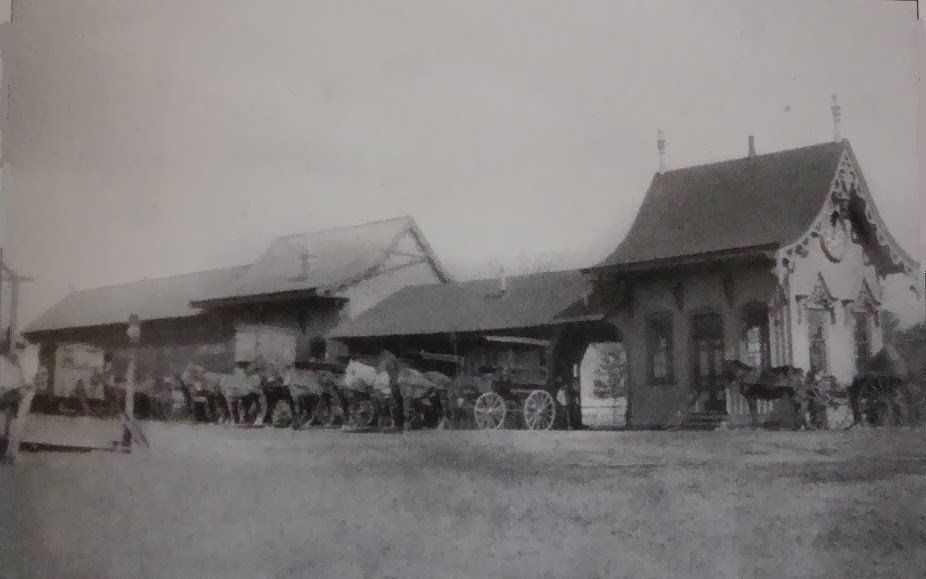
#9 Railroad Depot
Hutchinson Square
Listen to the Audio
The Railroad Depots
The modern trains of the Norfolk-Southern RR today ride on the original bed of the South Carolina Canal and Railroad Company of 1832. The first local Depot was along that quaint wooden rail line on W. Doty Ave., between modern S. Main St. and S. Cedar St. It was no more than a shed and was used primarily to supply water. In the Golden Age of the Inns, the Milburn designed Depot offered an impressive setting for the sophisticated, wealthy travelers from “off” who came to this little southern town seeking relief. When passenger service was discontinued in the 1960s, the Summerville Depot was demolished.
The Railroad Depots
• The modern trains of the Norfolk-Southern RR today ride on the original bed of the South Carolina Canal and Railroad Company of 1832.
• The first local Depot was along that quaint wooden rail line on W. Doty Ave., between modern S. Main St. and S. Cedar St. It was no more than a shed and was used primarily to supply water.
• The quaint Victorian building in the 1880s photograph that was replaced by the Southern Depot was moved a few mile east to become the Ladson Depot.
• For decades, the Southern Railroad Depot at Summerville was situated at the northern end of Hutchinson Square in a setting of oaks, looking like a bygone plantation manor house. It was the grandest descendant of more modest depots of history.
• In 1902, the Southern Railroad Depot was in service at Summerville. The grand building was designed by Frank Milburn, the premier architect of the South at the time. He had designed numerous southern commercial and college campus buildings, along with courthouses and railroad depots.
•In the Golden Age of Inns, the Milburn designed Depot offered an impresseive setting for the spohistiated, welathy travelers from "off" who came to this little southern town seeking relief.
• By the 1880s, there were several little buildings at the Depot. In an available photograph, the Depot appears to comprise a passenger waiting room with Victorian flourishes, a service platform, a storage shed and a carriage shelter. These probably accumulated over the years.
• A legend is associated with the distinctive little Victorian waiting room. A history of Summerville by Elizabeth Jamison, published in 1939 tells the story of the night of the great Earthquake of 1886 in which the stationmaster received a warning of a broken track, delivered by an unknown person he described as an “angel.” The stationmaster, one Frank Doar, proceeded up the dark track, discovered the break and stopped the crowded incoming passenger train, saving everyone from disaster. This recorded account is the basis of Mrs. Jamison’s history. Other documentation makes the history a legend.
• The earliest locomotives in the 1830s stored the water for their boilers in barrels on a small tender car just behind the locomotive. The RR workers at the Depot would have drawn the water two blocks west at the Laurel Street Branch, moved them to the Depot in a horse drawn wagon and rolled the barrels onto the tender. When activated, a rubber hose connected the barrel to the boiler on the little locomotive.
• In those days, delays were frequent and it was not unusual for the crew to run low on wood fuel and water. Often in these circumstances, paying passengers would “volunteer” to assist in remedying the problem – especially if they expected to reach their destinations
• In the 1870s, water was drawn from a well by a pump powered by a circling and harnessed horse. The water was then stored in the familiar wooden water tank alongside the track, elevated on posts. Water would be delivered through a spout by gravity into the boilers.
• When passenger service was discontinued in the 1960s, the Summerville Depot was demolished; the Ladson Depot is also now gone.
• Across the street from the museum garden is the original bed of the South Carolina Canal and Rail Road Company. The track was laid from Charleston to Augusta (1830-1832), forming the longest railroad line in America at the time.
• The original track was of two parallel wooden beams, each lined on the top surface with an iron rail. The track beams were entirely elevated on cypress posts.
• By 1836, traffic on the elevated rails had weakened the structure so that the rail line would have to be rebuilt or replaced.
• The rebuilding of the railroad resulted in the construction of banks of clay which are the basis of the modern railroad bed. These clay banks covered the original track. They were built by enslaved men and women who suffered greatly in the dangerous and difficult work.
• The railroad company owned a large tract of land at the Sawmill Branch. It planned to form a town where Charlestonians could own second homes and use the railroad as a commuter service to businesses in Charleston.



